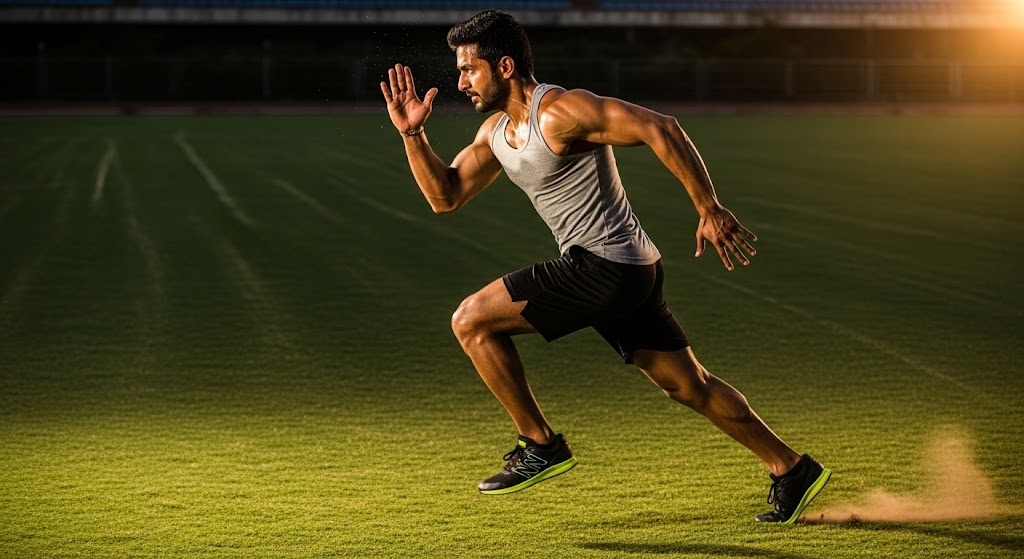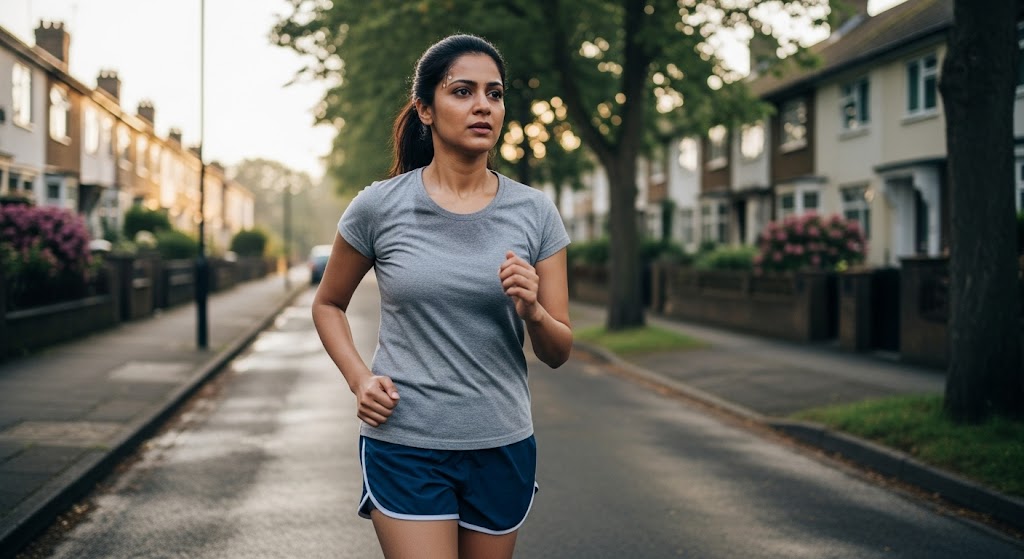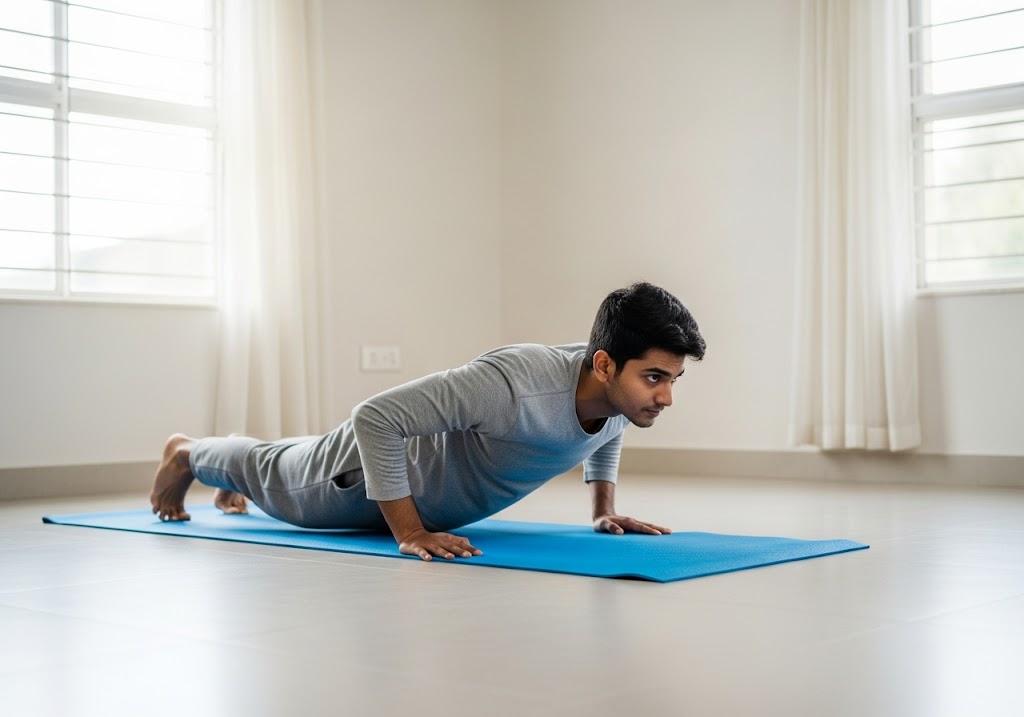How much to run to burn 500 calories? Run 40-60 minutes at moderate pace (8-10 km/h) or 25-35 minutes with high-intensity intervals, depending on your body weight and running intensity. Key factors determining how much to run to burn 500 calories are: Body weight, running pace, terrain difficulty, weather conditions, running experience, metabolism rate, running form efficiency, incline levels, interval vs steady-state, and individual fitness level.
Want to know exactly how much to run to burn 500 calories for effective weight loss? This complete running plan provides precise calculations based on your body weight, pace, and running style to achieve your calorie-burning goals efficiently and safely.
Table of Contents
Running Pace and Calorie Burn Relationship
Understanding the relationship between running pace and calorie expenditure helps determine exactly how much should i run to burn 500 calories. Faster paces burn more calories per minute but may not be sustainable for longer durations needed to reach 500-calorie targets.
| Body Weight | 6 km/h (Walking) | 8 km/h (Jogging) | 10 km/h (Running) | 12 km/h (Fast Run) |
|---|---|---|---|---|
| 60kg | 90 min | 65 min | 50 min | 42 min |
| 70kg | 75 min | 55 min | 43 min | 36 min |
| 80kg | 65 min | 48 min | 38 min | 32 min |
| 90kg | 58 min | 42 min | 34 min | 28 min |
The optimal approach for how much to run to burn 500 calories balances sustainable pace with achievable duration. Most runners find moderate intensities between 8-10 km/h provide the best combination of calorie burn and exercise sustainability for consistent training.
For beginners starting their running journey, bodyweight exercises for beginners provides excellent foundation strength training to support running performance.

Different Running Styles for 500-Calorie Burn
Various running approaches offer different strategies for achieving how much to run to burn 500 calories based on individual preferences, fitness levels, and time availability. Each style provides unique benefits while reaching the same calorie-burning target through different methods.
1. Steady-State Running
Steady-state running maintains consistent pace throughout the entire session for predictable calorie burn calculations. This approach allows precise planning for how much to run to burn 500 calories while building aerobic endurance and cardiovascular fitness effectively.
- Maintain consistent pace between 8-10 km/h for entire duration
- Focus on comfortable breathing rhythm throughout session
- Ideal for beginners building running endurance foundation
- Provides predictable calorie burn for accurate planning
- Builds aerobic base for more advanced training progression
2. Interval Running for Maximum Burn
High-intensity interval running alternates between fast and recovery paces to maximize calorie burn per minute. This method reduces total time needed for how much to run to burn 500 calories while improving both aerobic and anaerobic fitness systems.
- Alternate 2 minutes fast running with 1 minute recovery
- Repeat intervals for 35-45 minutes total duration
- Burns calories faster than steady-state running
- Improves speed and cardiovascular fitness simultaneously
- Creates afterburn effect for continued calorie burning
3. Hill Running for Increased Intensity
Hill running increases calorie expenditure significantly compared to flat terrain running. The added resistance from gravity requires more energy, reducing the time needed for how much should i run to burn 500 calories while building leg strength.
- Find hills with 5-8% grade for optimal intensity
- Run uphill for 2-3 minutes, walk down for recovery
- Repeat intervals for 30-40 minutes total session
- Burns 20-30% more calories than flat running
- Builds power and strength while burning calories
For understanding optimal training timing, is it better to do cardio before or after weights provides guidance on structuring combined training sessions.
4. Fartlek Training Method
Fartlek training combines structured intervals with spontaneous speed changes for varied intensity and calorie burn. This Swedish training method keeps workouts interesting while efficiently addressing how much to run to burn 500 calories through diverse pace changes.
- Mix steady running with spontaneous speed bursts
- Change pace based on landmarks or time intervals
- Combine different intensities within single session
- Keeps training mentally engaging and challenging
- Improves speed, endurance, and calorie burning simultaneously
Indoor vs Outdoor Running Calorie Burn
The environment significantly affects how much to run to burn 500 calories due to differences in air resistance, terrain variation, and environmental factors. Understanding these differences helps plan effective calorie-burning sessions regardless of location or weather conditions.
Outdoor running typically burns 5-10% more calories than treadmill running due to air resistance and terrain variation. Wind resistance increases energy expenditure while uneven surfaces require additional stabilization effort from supporting muscles throughout the running stride.
| Running Environment | Calorie Burn Rate | Duration for 500 Calories (70kg) | Advantages | Considerations |
|---|---|---|---|---|
| Treadmill (0% grade) | Baseline | 55 minutes | Controlled pace | Lower calorie burn |
| Treadmill (3% grade) | +15% | 48 minutes | Weather independent | Monotonous |
| Outdoor flat | +8% | 51 minutes | Fresh air, scenery | Weather dependent |
| Outdoor hills | +25% | 44 minutes | Maximum burn | Challenging |
Indoor running provides controlled conditions for consistent training regardless of weather, while outdoor running offers environmental variety and typically higher calorie expenditure for the same effort level in determining how much to run to burn 500 calories.
Discover how to burn 500 calories at home without equipment using bodyweight exercises that really work.

Running Duration vs Intensity for Calorie Burn
Balancing running duration and intensity determines the most effective approach for how much should i run to burn 500 calories based on individual fitness levels and time constraints. Both strategies achieve the same calorie target through different physiological pathways.
Lower intensity running for longer durations burns calories primarily through aerobic metabolism, making it sustainable for beginners and those building endurance base. This approach typically requires 45-70 minutes depending on body weight and pace selection for 500-calorie targets.
Higher intensity running burns calories through both aerobic and anaerobic systems, reducing total time needed but requiring higher fitness levels. Advanced runners can achieve how much to run to burn 500 calories in 25-40 minutes through high-intensity interval protocols and challenging pace maintenance.
Learn how to burn 500 calories a day with effective workouts and smart habits that fit your lifestyle.
Low-Intensity Long Duration
Low-intensity running emphasizes fat burning through aerobic metabolism while building endurance capacity. This approach suits beginners and those preferring steady, sustainable efforts for achieving how much to run to burn 500 calories consistently.
Maintain heart rate at 60-70% maximum throughout extended sessions lasting 50-70 minutes. This intensity allows conversation while running and can be sustained comfortably by most individuals with basic fitness levels.
High-Intensity Short Duration
High-intensity running maximizes calorie burn per minute through elevated heart rate and increased oxygen consumption. This approach suits time-constrained individuals and advanced runners seeking efficient calorie burning in minimal time.
Target heart rate of 80-90% maximum during work intervals with active recovery periods. Total session duration of 25-40 minutes including warm-up and cool-down periods achieves 500-calorie targets through intense effort phases.
Understanding proper warm-up protocols, warm up exercises for beginners ensures safe preparation for high-intensity running sessions.
Beginner Running Plan for 500 Calories
Beginning runners require progressive approaches to safely achieve how much to run to burn 500 calories without overuse injuries or excessive fatigue. This structured plan builds running capacity gradually while working toward consistent 500-calorie burning sessions.
Week 1-2 focus on walk-run intervals to build basic aerobic capacity and running form. Alternate 2 minutes walking with 1 minute easy running for 30-40 minutes total duration, burning approximately 250-350 calories per session.
| Week | Format | Duration | Intensity | Expected Calories | Progression Focus |
|---|---|---|---|---|---|
| 1-2 | Walk-Run | 35 min | Very Easy | 300-350 | Base building |
| 3-4 | Run-Walk | 40 min | Easy | 350-400 | Endurance |
| 5-6 | Continuous | 45 min | Easy-Moderate | 400-450 | Consistency |
| 7-8 | Varied Pace | 50 min | Moderate | 450-500 | Target achievement |
Progressive overload through gradual duration increases prevents injury while building the cardiovascular and musculoskeletal adaptations necessary for sustained 500-calorie running sessions. Focus on consistency rather than speed during initial training phases.
Intermediate Running Strategies
Intermediate runners can employ varied strategies for efficiently achieving how much should i run to burn 500 calories through different training methods. These approaches provide options based on available time, fitness goals, and training preferences for continued advancement.
Tempo Running Sessions
Tempo running maintains comfortably hard pace just below lactate threshold for sustained periods. This training method efficiently burns calories while improving running economy and lactate clearance capacity for better overall performance and endurance.
- Warm up 10 minutes at easy pace
- Run 20-25 minutes at tempo pace (can speak 3-4 words)
- Cool down 10 minutes at easy pace
- Total duration: 40-45 minutes
- Expected calorie burn: 500-600 calories
Long Slow Distance Method
Long slow distance running builds aerobic base while burning significant calories through extended duration at comfortable intensity. This method develops fat-burning efficiency while achieving how much to run to burn 500 calories through time investment rather than intensity.
Maintain conversational pace for 55-70 minutes depending on body weight and running efficiency. This approach builds endurance while burning calories primarily from fat stores, improving metabolic efficiency for weight management goals.
For comprehensive training integration, full body calisthenics workout provides strength training that complements running performance and injury prevention.

Advanced Running Techniques for Maximum Calorie Burn
Advanced runners can maximize calorie burn efficiency through sophisticated training methods that reduce time needed for how much to run to burn 500 calories. These techniques require solid fitness foundation and proper recovery protocols.
High-Intensity Interval Training
HIIT running alternates maximum effort periods with recovery intervals for superior calorie burn per minute. This method achieves how much to run to burn 500 calories in minimal time while improving both speed and endurance capabilities simultaneously.
- 5-minute warm-up at easy pace
- 8 rounds of 2 minutes hard, 1 minute easy
- 5-minute cool-down at easy pace
- Total duration: 34 minutes
- Expected calorie burn: 500-650 calories
Pyramid Interval Training
Pyramid intervals progressively increase then decrease work duration within single session. This method provides varied stimulus while efficiently addressing how much should i run to burn 500 calories through structured intensity progression.
Run intervals of 1-2-3-4-3-2-1 minutes at hard effort with equal recovery periods between each work interval. Total workout duration of 35-40 minutes including warm-up and cool-down achieves 500+ calorie targets.
Track Workouts for Precision
Track running provides precise distance measurement for accurate calorie calculations and performance monitoring. Standard 400-meter tracks allow specific workout structures for achieving how much to run to burn 500 calories with measurable progression.
Run 400-meter repeats at 5K race pace with 200-meter recovery jogs. Complete 12-15 repetitions for approximately 500-calorie expenditure while improving speed and running efficiency through structured training stimulus.
Running Nutrition for Optimal Calorie Burn
Proper nutrition supports running performance while optimizing calorie burn efficiency for achieving how much to run to burn 500 calories consistently. Strategic fueling enhances exercise capacity while supporting recovery and adaptation from regular running training.
Pre-run nutrition should provide easily digestible carbohydrates for immediate energy availability without causing digestive discomfort during exercise. Light meals or snacks 1-2 hours before running optimize performance while preventing energy depletion during longer sessions.
Post-run nutrition focuses on recovery and glycogen replenishment within 30-60 minutes after exercise completion. Combining protein and carbohydrates supports muscle recovery while preparing for subsequent training sessions and continued calorie-burning goals.
| Timing | Focus | Examples | Purpose |
|---|---|---|---|
| 2 hours pre-run | Carbohydrates | Oats, banana | Energy availability |
| 30 min pre-run | Light fuel | Sports drink | Immediate energy |
| During long runs | Hydration | Water, electrolytes | Performance maintenance |
| Post-run | Recovery | Protein shake, fruit | Adaptation support |
Hydration becomes critical during extended running sessions needed for how much to run to burn 500 calories. Adequate fluid intake before, during, and after running maintains performance while supporting thermoregulation and cardiovascular function.
For comprehensive nutritional strategies, intermittent fasting plan provides structured eating approaches that complement running training for weight management goals.

Running Safety and Injury Prevention
Safe running practices enable consistent training necessary for regularly achieving how much should i run to burn 500 calories without interruption from preventable injuries. Proper preparation and progression prevent common running-related problems while maintaining training continuity.
Proper Running Form
Efficient running form reduces energy waste while minimizing injury risk during extended sessions needed for 500-calorie targets. Focus on midfoot landing, slight forward lean, and relaxed arm swing for optimal running economy and reduced impact forces.
Maintain cadence around 170-180 steps per minute regardless of pace to optimize stride efficiency. Higher cadence reduces overstriding and impact forces while improving running economy for better performance and injury prevention during regular training.
Progressive Training Load
Gradual training progression prevents overuse injuries that interrupt consistent running for how much to run to burn 500 calories. Follow the 10% rule by increasing weekly mileage by no more than 10% to allow proper adaptation.
Include rest days and easy running in weekly schedules to promote recovery and adaptation. Hard training days should be followed by easy or rest days to prevent excessive fatigue accumulation and maintain training quality over time.
For recovery optimization, what is foam rolling provides essential self-massage techniques that support running performance and injury prevention.
Environmental Considerations
Weather conditions significantly affect running safety and performance when pursuing how much to run to burn 500 calories in various environments. Hot weather increases calorie burn but also heat stress risk, while cold conditions may require longer warm-up periods.
Adjust running intensity and duration based on temperature, humidity, and air quality conditions. Extreme heat requires slower paces and increased hydration, while cold weather may allow higher intensities with proper warm-up preparation and appropriate clothing.
For post-exercise recovery strategies, cold shower vs hot shower explains optimal recovery methods following intense running sessions.
Tracking Progress and Motivation
Monitoring running progress provides motivation while enabling program adjustments for continued advancement toward consistent how much to run to burn 500 calories achievements. Various tracking methods quantify improvements while maintaining accountability for long-term success.
Technology Tools for Runners
GPS watches and smartphone apps provide real-time feedback on pace, distance, and estimated calorie burn during running sessions. These tools help maintain target intensities while tracking progress toward 500-calorie goals with precision and convenience.
Heart rate monitors offer intensity guidance for optimal calorie burn zones during different running workouts. Maintaining target heart rate ranges ensures appropriate intensity for specific training goals while maximizing calorie expenditure efficiency.
Setting Realistic Running Goals
Establish achievable targets for how much should i run to burn 500 calories based on current fitness level and available time. Progressive goal setting prevents frustration while maintaining motivation for continued advancement in running performance and calorie-burning capacity.
Weekly running targets prove more manageable than daily perfection requirements. Aim for 3-4 successful sessions weekly rather than perfect daily adherence for realistic goal achievement and sustainable progress toward fitness objectives.
Common Running Mistakes for Calorie Burning
Avoiding frequent errors accelerates progress while preventing frustration and potential injuries when determining how much to run to burn 500 calories. These mistakes often limit calorie burn effectiveness and may lead to training plateaus or overuse problems.
- Starting Too Fast: Beginning with excessive pace leads to early fatigue and inability to maintain calorie-burning duration
- Ignoring Recovery: Insufficient rest between sessions prevents adaptation and increases injury risk significantly
- Poor Pacing Strategy: Inconsistent pace reduces efficiency and may prevent reaching 500-calorie targets
- Inadequate Hydration: Dehydration impairs performance and reduces calorie-burning capacity during extended sessions
- Wearing Wrong Shoes: Improper footwear increases injury risk and reduces running efficiency substantially
- Neglecting Warm-up: Cold muscles are prone to injury and perform poorly during calorie-burning sessions
Running Surface Effects on Calorie Burn
Different running surfaces affect energy expenditure and total calories burned during sessions aimed at how much to run to burn 500 calories. Understanding these differences helps optimize training location selection for maximum calorie burn efficiency.
Soft surfaces like sand, grass, and trails require more energy than hard surfaces due to reduced energy return and increased stabilization demands. Beach running can increase calorie burn by 30-50% compared to pavement due to sand instability and resistance.
| Surface Type | Calorie Burn Modifier | Injury Risk | Advantages | Considerations |
|---|---|---|---|---|
| Pavement | Baseline | Moderate | Consistent pace | High impact |
| Track | +2% | Low | Precise measurement | Can be monotonous |
| Treadmill | -5% | Low | Weather independent | Less engaging |
| Grass/Trails | +10% | Low | Joint friendly | Uneven footing |
| Sand | +30% | Very Low | Maximum burn | Very challenging |
Trail running provides natural interval training through elevation changes and terrain variation, increasing calorie burn while reducing monotony. The varied surface challenges different muscle groups while providing scenic environments for improved training enjoyment.
Weather Impact on Running Calorie Burn
Weather conditions significantly influence how much should i run to burn 500 calories due to effects on thermoregulation, air resistance, and exercise capacity. Understanding these impacts helps plan effective training regardless of environmental conditions.
Hot weather increases calorie burn through elevated heart rate and cooling demands but may require reduced intensity to prevent overheating. Cold weather may initially require more calories for thermoregulation but allows higher sustainable intensities once warmed up properly.
Hot Weather Running
High temperatures increase metabolic demands and calorie burn but also heat stress risk. Reduce pace by 10-20% in temperatures above 25°C while increasing hydration to maintain performance and safety during extended calorie-burning sessions.
Early morning or evening running avoids peak heat while maintaining training consistency. Lightweight, light-colored clothing and frequent hydration support performance in challenging thermal conditions when pursuing 500-calorie targets.
Cold Weather Running
Cold conditions may increase initial calorie burn through shivering thermogenesis but typically allow higher sustainable running intensities. Proper layering prevents overheating while maintaining warmth during warm-up and cool-down periods.
Extended warm-up periods prepare muscles and cardiovascular system for intense effort in cold conditions. Gradual intensity progression prevents injury while optimizing calorie burn potential during challenging weather conditions.
Understanding recovery considerations, should you exercise with sore muscles provides guidance for training through minor discomfort while preventing injury progression.

Age and Gender Considerations for Running
Age and gender influence calorie burn rates and running capacity when determining how much to run to burn 500 calories. Understanding these factors helps create realistic expectations and appropriate training modifications for different populations.
Men typically burn 10-15% more calories than women at the same body weight due to higher muscle mass and metabolic rate. Age-related declines in metabolism and cardiovascular capacity may require longer durations or modified intensities to achieve 500-calorie targets.
Age-Related Modifications
Older runners may require longer warm-up periods and recovery between sessions while potentially needing extended durations for how much to run to burn 500 calories. However, experienced older runners often demonstrate superior running economy that partially compensates for age-related changes.
Progressive training becomes increasingly important with age to prevent injury while building capacity. Focus on consistency and gradual progression rather than aggressive advancement for sustainable long-term running development.
Gender-Specific Considerations
Female runners may need slightly longer durations to achieve 500-calorie targets due to differences in muscle mass and metabolism. However, women often demonstrate superior endurance capacity and fat-burning efficiency during extended exercise sessions.
Hormonal fluctuations may affect energy levels and performance across menstrual cycles. Adjust training intensity and expectations based on individual responses while maintaining consistency in weekly training volume and calorie-burning goals.
Building Long-Term Running Habits
Creating sustainable running habits for consistently achieving how much should i run to burn 500 calories requires strategic planning and realistic expectations. Focus on building consistent patterns rather than pursuing perfect execution for long-term success.
Start with achievable targets and gradually progress toward 500-calorie goals over several weeks or months. Consistency with shorter sessions proves more beneficial than sporadic longer runs for habit formation and fitness development.
Motivation Strategies
Variety in running routes, intensities, and training partners prevents boredom while maintaining engagement with regular calorie-burning goals. Social running groups provide accountability and motivation for consistent training participation and continued advancement.
Setting process goals rather than outcome goals maintains motivation during challenging periods. Focus on completing scheduled runs rather than perfect pace or calorie targets for sustainable habit formation.
Seasonal Training Adaptations
Adjust running strategies based on seasonal changes in weather, daylight, and schedule demands. Indoor alternatives during extreme weather maintain training consistency while outdoor variety during favorable conditions enhances enjoyment and sustainability.
Plan training blocks around seasonal schedules and commitments to maintain consistency in how much to run to burn 500 calories throughout the year. Flexibility in timing and location accommodates life demands while preserving training momentum.
Conclusion
Understanding how much to run to burn 500 calories empowers you to create effective, personalized training plans that achieve weight loss goals through strategic running approaches. Whether you prefer steady-state endurance runs, high-intensity intervals, or varied terrain challenges, the key lies in matching running duration and intensity to your fitness level and time availability. By applying these evidence-based strategies for how much should i run to burn 500 calories, you can confidently plan running sessions that deliver consistent calorie burn while building cardiovascular fitness, endurance, and long-term health benefits through sustainable running practices.
Want to master the calisthenics handstand and take your skills to the next level? Whether you’re a beginner or pushing advanced skills, ISC – Indian School of Calisthenics offers expert guidance to help you master bodyweight training. Visit us at SRPF Ground, NH8, Goregaon (E), Mumbai – 400065. For class schedules, personalized coaching, or more details, call +91 77159 53218. Train smart, move better, and unlock your back strength with ISC.
How Much to Run to Burn 500 Calories? – FAQs
How much should I run to burn 500 calories?
Run 40-60 minutes at moderate pace (8-10 km/h) depending on body weight, or 25-35 minutes with high-intensity intervals for 500-calorie burn.
How long should I run to burn 500 calories?
Duration varies by weight and pace: 60kg person needs 50 minutes at 10 km/h, while 80kg person needs 38 minutes at same pace.
Does running pace affect calorie burn significantly?
Yes, faster paces burn more calories per minute but may not be sustainable for full 500-calorie sessions without interval training.
Can I burn 500 calories running for 30 minutes?
Yes, possible for heavier individuals (80kg+) running at fast pace (12+ km/h) or through high-intensity interval training protocols.
Is treadmill or outdoor running better for calorie burn?
Outdoor running typically burns 5-10% more calories due to air resistance and terrain variation compared to treadmill running.
How does body weight affect running calorie burn?
Heavier individuals burn more calories: 90kg person burns approximately 30% more calories than 60kg person at identical pace and duration.
Should I run daily to burn 500 calories?
Not recommended daily due to injury risk; aim for 3-4 sessions weekly with rest days for recovery and adaptation.
Does running uphill burn more calories?
Yes, hill running increases calorie burn by 20-30% compared to flat terrain due to increased gravitational resistance and effort.
What’s the best running intensity for 500 calories?
Moderate intensity (8-10 km/h) provides optimal balance of sustainability and calorie burn for most people achieving 500-calorie targets.
How accurate are fitness trackers for running calories?
Fitness trackers provide reasonable estimates within 10-15% accuracy when programmed with correct body weight, age, and heart rate data.


